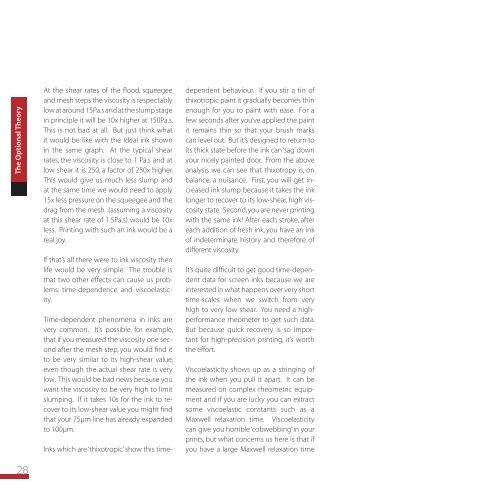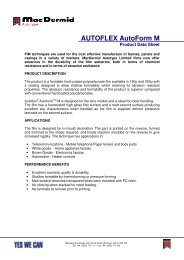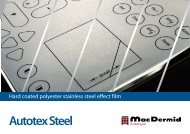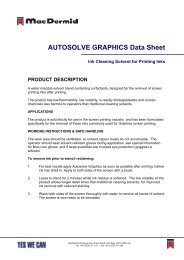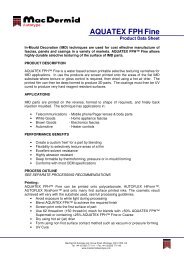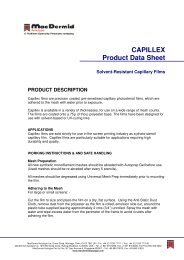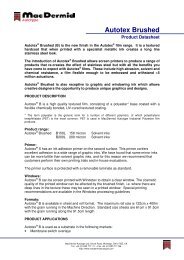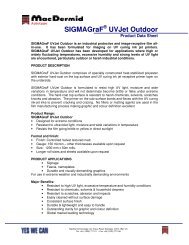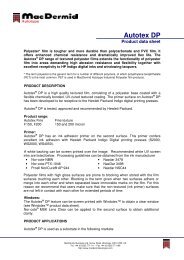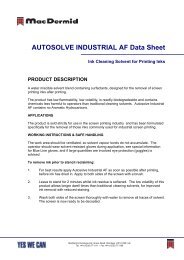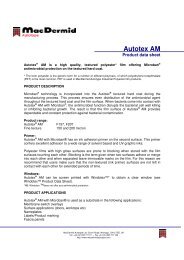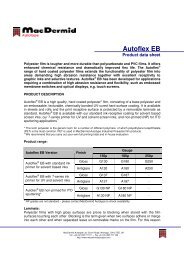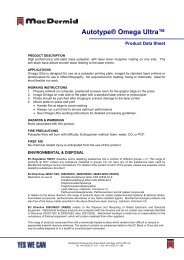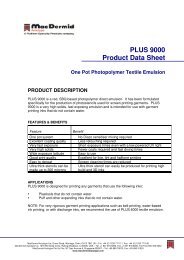Screen E-Book (.PDF) - MacDermid Autotype
Screen E-Book (.PDF) - MacDermid Autotype
Screen E-Book (.PDF) - MacDermid Autotype
- No tags were found...
You also want an ePaper? Increase the reach of your titles
YUMPU automatically turns print PDFs into web optimized ePapers that Google loves.
The Optional Theory28At the shear rates of the flood, squeegeeand mesh steps the viscosity is respectablylow at around 15Pa.s and at the slump stagein principle it will be 10x higher at 150Pa.s.This is not bad at all. But just think whatit would be like with the Ideal ink shownin the same graph. At the typical shearrates, the viscosity is close to 1 Pa.s and atlow shear it is 250, a factor of 250x higher.This would give us much less slump andat the same time we would need to apply15x less pressure on the squeegee and thedrag from the mesh (assuming a viscosityat this shear rate of 1.5Pa.s) would be 10xless. Printing with such an ink would be areal joy.If that’s all there were to ink viscosity thenlife would be very simple. The trouble isthat two other effects can cause us problems:time-dependence and viscoelasticity.Time-dependent phenomena in inks arevery common. It’s possible, for example,that if you measured the viscosity one secondafter the mesh step, you would find itto be very similar to its high-shear value,even though the actual shear rate is verylow. This would be bad news because youwant the viscosity to be very high to limitslumping. If it takes 10s for the ink to recoverto its low-shear value you might findthat your 75µm line has already expandedto 100µm.Inks which are ‘thixotropic’ show this timedependentbehaviour. If you stir a tin ofthixotropic paint it gradually becomes thinenough for you to paint with ease. For afew seconds after you’ve applied the paintit remains thin so that your brush markscan level out. But it’s designed to return toits thick state before the ink can ‘sag’ downyour nicely painted door. From the aboveanalysis we can see that thixotropy is, onbalance, a nuisance. First, you will get increasedink slump because it takes the inklonger to recover to its low-shear, high viscositystate. Second, you are never printingwith the same ink! After each stroke, aftereach addition of fresh ink, you have an inkof indeterminate history and therefore ofdifferent viscosity.It’s quite difficult to get good time-dependentdata for screen inks because we areinterested in what happens over very shorttime-scales when we switch from veryhigh to very low shear. You need a highperformancerheometer to get such data.But because quick recovery is so importantfor high-precision printing, it’s worththe effort.Viscoelasticity shows up as a stringing ofthe ink when you pull it apart. It can bemeasured on complex rheometric equipmentand if you are lucky you can extractsome viscoelastic constants such as aMaxwell relaxation time. Viscoelasticitycan give you horrible ‘cobwebbing’ in yourprints, but what concerns us here is that ifyou have a large Maxwell relaxation time


